
CES in 2018 left little to the imagination for what's coming down the pipe for all of us technophiles. With almost 3 million square feet of show floor there was no shortage of interesting gizmos, gadgets, wearables, and drones. Fair warning, this article is an overview of things I personally found interesting; I have no doubt that I will miss writing about several innovative products or future must have purchases for all of us. With that said, I’ll jump in...
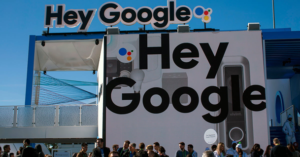
Theme of the show: Smart Assistants
Google Home and Amazon Alexa are both doubling down and in it to win it. While neither of these products are new, their showing at CES has them leaping way ahead of Apple, Samsung and Microsoft (Siri, Bixby, and Cortana, respectively). Everything from your toilet to your shower, home automation and entertainment system manufacturers are racing to integrate one or both of these services into their devices. That means it's not just Google and Amazon making a big bet, but hundreds of device manufacturers collectively investing thousands of engineering hours into their own products. Which really means all of us tinker-ers probably won’t need to be using quite as much IFTTT gymnastics, since we can just yell at our semi-creepy-voice-box-AI. Let’s see if consumers buy-in. I for one don’t see myself yelling “Hey Google” before turning on my shower, but I might be convinced for integrations with my Sonos, home automation and entertainment.
AR/VR:
While CES isn’t E3 or GDC and thus AR/VR are not a central theme, there were still plenty of big announcements and cool innovations on display.
Black-Box VR:
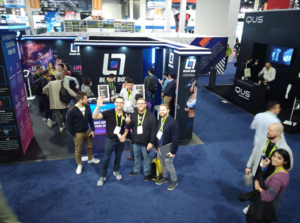 I can’t say enough about how excited/proud I am about Boise locals Black Box VR and their resistance VR gym system. It’s one thing to attend CES as a showcase, it’s entirely another to win awards and accolades, and well deserved they are. Blackbox was honored with a CES Innovation award, and Engadget’s Best of CES “Best Startup” award. Not to mention press coverage from the BBC, Today Show, Business Insider, and countless others.
I can’t say enough about how excited/proud I am about Boise locals Black Box VR and their resistance VR gym system. It’s one thing to attend CES as a showcase, it’s entirely another to win awards and accolades, and well deserved they are. Blackbox was honored with a CES Innovation award, and Engadget’s Best of CES “Best Startup” award. Not to mention press coverage from the BBC, Today Show, Business Insider, and countless others.
I’ve played with several versions of Black Box’s system leading up to the demo showcased at CES. Let me tell you, it’s no joke, and this isn’t your grandma’s standard HTC VIVE setup. With each version getting more sophisticated it really makes working-out some weird-but-awesome cross between video games and a personal trainer. The magic comes from it’s seamless integration with their custom weight system/machine paired with the VIVE. This bad-boy’s integration with the game/workout helps push you through those tough reps and distracts your mind with a good old fashioned video game. All I can say is sign my out-of-shape gamer ass up… I’m sold.
HTC VIVE Pro:
What can I say other than, about damn time. I hate getting into relationships with hardware makers where I start feeling like they “owe” me upgrades. However, with the current VIVE being 2 years old and brand-new out-of-the-boxes always feeling like a demo model… it was about time. Featuring upgraded resolution (1440 x 1600 pixels per eye, 2880 x 1600 pixels combined), built in 3D spacial audio and *cough* finally, a wireless adapter (additional upgrade), and – maybe most importantly – multiplayer tracking… this feels more like the VIVE that should have always been.
Standalone VR Systems:
I am pretty sure most people have realized that plopping your phone into a “VR” headset is pretty lame and was sooooo 2015. Gear VR and Google’s daydream being the leaders in this space always felt like a gimmick, useless and uninspired to me. Call me a spoiled naysayer, but the magic of VR is the complete immersion, and these platforms had low performance and were always a little glitchy. Because of that, they never really immersed users completely in an experience, thus did a disservice to the industry as a whole… just one man's opinion.
With that said, CES saw an array of announcements from Facebook about the Oculus Go, Lenovo’s Mirage Solo and upgraded standalone Google’s Daydream. I am skeptical these devices will be able to pack anything close to the punch my VIVE can (it’s a fact they won’t), but this does seem like a step in the right direction for VR to find a home outside of gaming and increase the accessibility for the average users. Moral of the story, with a device solely dedicated to running VR apps, I finally I can pick one of these up and give my poor, low-graphics performance iPhone a rest.
WayRay’s Navion in-car HUD:
While I hesitate to call this AR in the industry standard sense, it’s cool nonetheless. Why am I excited? Aside from the hardware, they have an open AR SDK, meaning there are plenty of opportunities to mess with their tech. I am happy to file this under products I may actually buy.
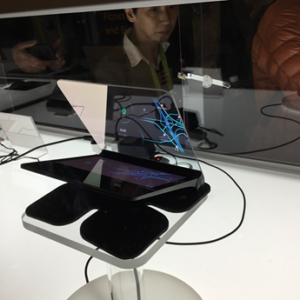
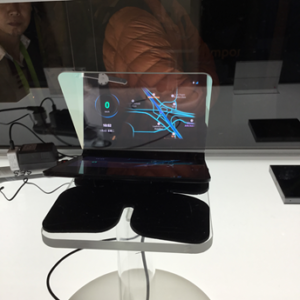
Merge VR:
Normally I am quick to poo-poo on mixed reality experiences that rely on your phone. However, Merge VR has a pretty interesting take on these experiences that use an array of low-cost “devices.” I use that term loosely since they really have made accessible plastic AR and VR enablers that interact with your phone in some creative and interesting ways. Two products I find pretty innovative/interesting are their Cube and 6Dof Blaster.
The Cube creates a platform standard tracker for AR intended to be held in your hands. I’ve yet to see anyone else take this approach to AR experiences where the physical “thing” becomes a platform for a variety of experiences instead of just a single use. Merge pulls this off better then I would have expected. I was personally extremely impressed how well it maintains the tracking while moving it around – well done. With a price tag of $5 for the cube, at a minimum it’s worth the novel experience of picking one up to get your creative juices flowing.
6Dof Blaster is a step in the right direction for making our phones into fun gaming devices. I was pretty giddy to be holding a ray gun in my hand mapped to a standard play area and getting to shoot digital enemies. Again, as with the Cube, Merge does a great job pulling something technically difficult off seamlessly. My first thought after playing the demo was: “make multiplayer capabilities and everyone will want one!” Easier said than done, but it would be a game changer for this device.
Keep it up, Merge. This is cool stuff.
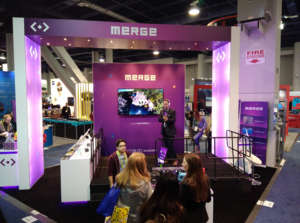
Really Innovative thinking:
The following items caught me off guard by how different and innovative they are. While most devices/products at CES are an evolution of another product or idea and very predictable, these are a little more forward-looking. I found all of these showcases to show some serious out of the box thinking and the kind of innovative thought that makes conferences like CES worth attending.
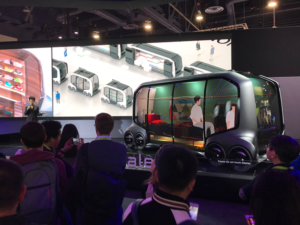
Toyota E-Pallet:
The Toyota E-Pallet is a fully autonomous mobile store. I see a use case where, say, a consumer is interested in buying a TV – with the E-pallet, they could select the 10 from Amazon they’d be interested in checking out and the e-pallet would roll up to their house to demo those 10 models. I see a million applications for this technology, which adds a nice bridge from our warehouse economy and completely disrupts the retail store market.
While just a concept, and unlikely to be seen in the next 5-10 years, Toyota’s E-Pallet is disruptive thinking at its finest, and seems like a fantastic way to lower cost to retailers.
The Foldimate is both the most useless and the most awesome device I saw at CES. Foldimate is a robot that folds your clothes. I don’t care who you are, nobody likes folding clothes; and if you do, we can’t be friends anymore (or — did you just became my best friend?!). Here’s the catch: the Foldimate can only fold one article of clothing at a time… and they plan to launch v1.0 like that with a near $1,000 price tag. How useless.
With that said, this a great step in the innovation chain. Eventually, I imagine a device like this just being built into the side of our standard dryers and just kicking the whole bin over and folding the entire load. Socks are going to be its worst enemy… nothing new there.
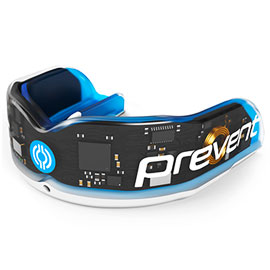 While checking out Black Box VR’s incredible setup (mentioned above), I came across one of the more innovative wearables at CES – Prevent Biometrics’ concussion-sensing mouthguard. If anyone out there was watching football last Sunday, when the Patriots’ Rob Gronkowski took a helmet-to-helmet blow, it was rather obvious that he had sustained a concussion based purely on his reaction. Unfortunately, not all concussions are that easily recognized. That’s precisely why the Head Impact Monitor System is so valuable. Thresholds for force are set, and when a hit exceeds that threshold the coach and training staff are immediately alerted to remove the player from the game and test them for a concussion. Designed with four accelerometers and an LED light that lights up when a player receives a significant hit to the head, HIMS is a huge step in the right direction for youth, adolescent, and professional athletes alike. Personally, I believe a device such as this can make a major difference in reducing one of the largest issues in sports today.
While checking out Black Box VR’s incredible setup (mentioned above), I came across one of the more innovative wearables at CES – Prevent Biometrics’ concussion-sensing mouthguard. If anyone out there was watching football last Sunday, when the Patriots’ Rob Gronkowski took a helmet-to-helmet blow, it was rather obvious that he had sustained a concussion based purely on his reaction. Unfortunately, not all concussions are that easily recognized. That’s precisely why the Head Impact Monitor System is so valuable. Thresholds for force are set, and when a hit exceeds that threshold the coach and training staff are immediately alerted to remove the player from the game and test them for a concussion. Designed with four accelerometers and an LED light that lights up when a player receives a significant hit to the head, HIMS is a huge step in the right direction for youth, adolescent, and professional athletes alike. Personally, I believe a device such as this can make a major difference in reducing one of the largest issues in sports today.
IBM Quantum computer:
Like several of the other items I’ve talked about in this article, IBM’s quantum computer isn’t new. In fact, it’s oddly out of place at CES, considering none of us are going to have one of these bad boys in our homes for personal computing in the next 15 years (nor is it particularly good at that kind of computing anyways). I include it here because this is raw, wild-West style innovation that only IBM can pull off: “science for the sake of science, technology for the sake of technology, and we’ll figure out how to make money off of it later; no market research studies or consumer tests.” And yet, out of all the things at CES, this was the only thing I was in awe of… utter brilliance and beauty. There is a good chance I’ll never get to see it like this again since it’s normally kept in temperatures colder than space (the pictured quantum computer is for display and is not operating). I’d pay many times more my CES ticket to get one day in the IBM lab where it’s made… take note IBM, direct-to-consumer monetization strategy.
Well folks, that's it for now. Special thanks to the IVRC for allowing me to guest blog and for my other partners at VYNYL who put up with my adventures. I look forward to continuing to see our industry grow and evolve.

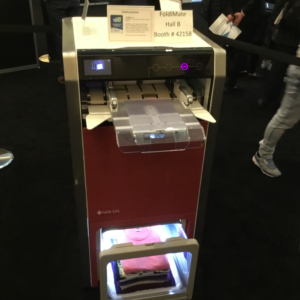


Recent Comments